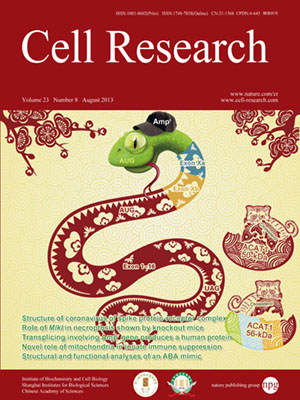
Volume 23, No 8, Aug 2013
ISSN: 1001-0602
EISSN: 1748-7838 2018
impact factor 17.848*
(Clarivate Analytics, 2019)
Volume 23 Issue 8, August 2013: 986-993
ORIGINAL ARTICLES
Structure of MERS-CoV spike receptor-binding domain complexed with human receptor DPP4
Nianshuang Wang1,*, Xuanling Shi2,*, Liwei Jiang2, Senyan Zhang1, Dongli Wang1, Pei Tong1, Dongxing Guo2, Lili Fu2, Ye Cui1, Xi Liu1, Kelly C Arledge2, Ying-Hua Chen1, Linqi Zhang2 and Xinquan Wang1
1Ministry of Education Key Laboratory of Protein Science, Center for Structural Biology, School of Life Sciences, Tsinghua University, Beijing 100084, China
2Comprehensive AIDS Research Center, Research Center for Public Health, School of Medicine, Tsinghua University, Beijing 100084, China
Correspondence: Correspondence: Xinquan Wang, E-mail: xinquanwang@mail.tsinghua.edu.cn; Linqi Zhang, E-mail: zhanglinqi@tsinghua.edu.cn*These two authors contributed equally to this work.
The spike glycoprotein (S) of recently identified Middle East respiratory syndrome coronavirus (MERS-CoV) targets the cellular receptor, dipeptidyl peptidase 4 (DPP4). Sequence comparison and modeling analysis have revealed a putative receptor-binding domain (RBD) on the viral spike, which mediates this interaction. We report the 3.0 Å-resolution crystal structure of MERS-CoV RBD bound to the extracellular domain of human DPP4. Our results show that MERS-CoV RBD consists of a core and a receptor-binding subdomain. The receptor-binding subdomain interacts with DPP4 β-propeller but not its intrinsic hydrolase domain. MERS-CoV RBD and related SARS-CoV RBD share a high degree of structural similarity in their core subdomains, but are notably divergent in the receptor-binding subdomain. Mutagenesis studies have identified several key residues in the receptor-binding subdomain that are critical for viral binding to DPP4 and entry into the target cell. The atomic details at the interface between MERS-CoV RBD and DPP4 provide structural understanding of the virus and receptor interaction, which can guide development of therapeutics and vaccines against MERS-CoV infection.
10.1038/cr.2013.92
FULL TEXT | PDF
Browse 2881


